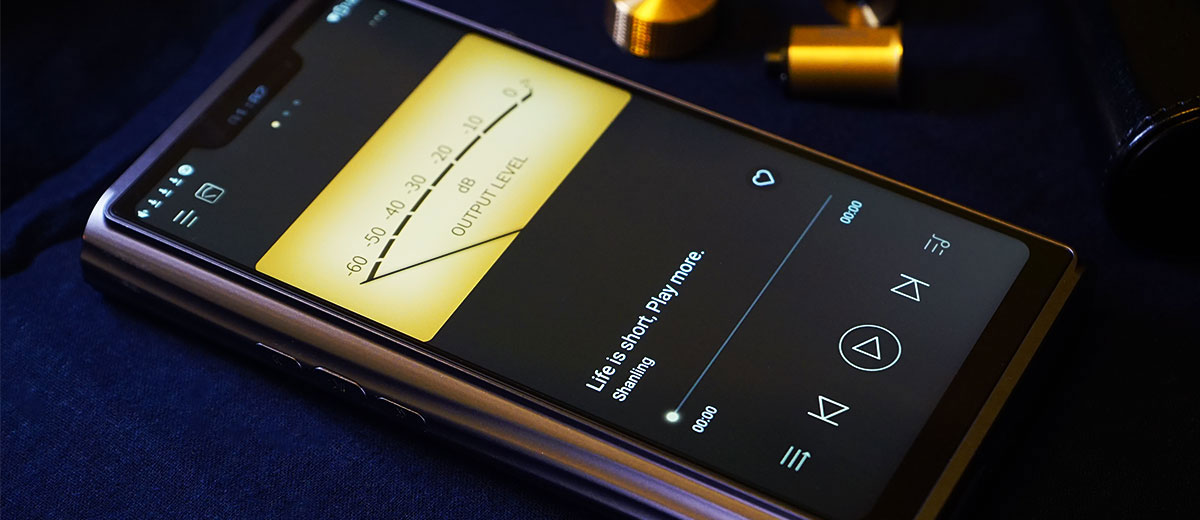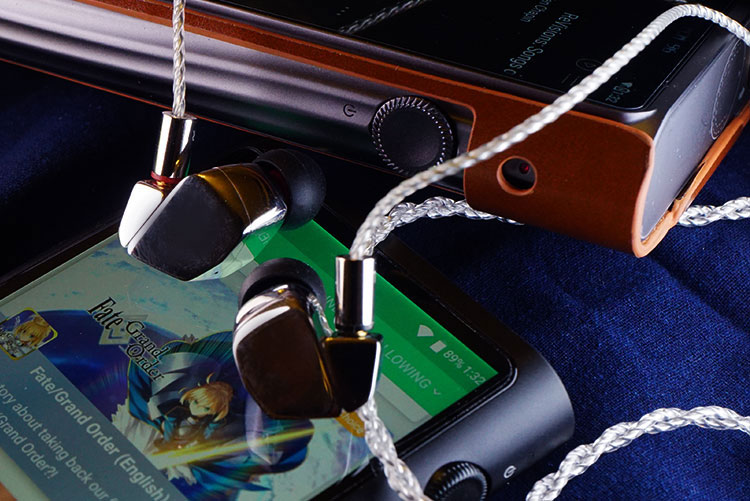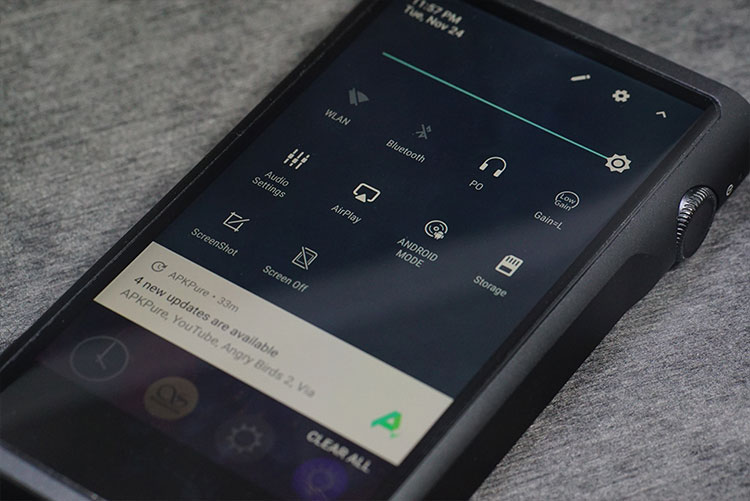Synergy
Power
The form factor is quite a big jump from the last generation TOTL player M8 and as such there is no surprise the M9 can make a leap in performance, taking the output to what I perceive as “desktop setup” level comparable to the power delivered by small desktop amplifiers.
On paper, the M9 isn’t as scarily powerful as the FiiO M17 though when you test it the power is almost overwhelming with the highest gain or Prime mode. In fact, sensitive IEMs like the Andromeda 2020 sound really dynamic with low gain with middle gain on earphone mode easily driving the Final A8000 full and highly resolving.
Putting the HD650 on the M9 it also displays excellent firmness in bass and intense, tightly imaged treble which is satisfactorily engaging for casual listening. With a total of 6 different combinations between gain modes and dedicated headphone mode, there is a lot of flexibility so it may not be a bad idea to try the higher current mode with some dynamic IEMs.
Efficiency
The output impedance is as low as <1 ohm on the M9. When paired with very sensitive IEMs, even custom monitors the background is very quiet even on higher-gain modes.
The noise control is the best I have heard on a Shanling DAP so far, even with very sensitive IEMs like the HUM Pristine and the Andromeda 2020, the background is dead silent.
To let headphones sound dynamic and punchy, switching on the Turbo mode is of great help. It feels like an N2O boost into the engine, kicking more power into the bass punch and imaging the midrange elements more distinctively. Using IEMs with Turbo mode may feel like having over-driving but if you have 300Ω earbuds this may be worth a try.
Pairings
The M9 has sufficient power to drive most IEMs with the 4.4mm output giving you the highest dynamic range and bass layering.
Testing with the ME800, the latest IEM released as a suite for the M9, the synergy is excellent and the bass sounds impressively deep and detailed. The staging is huge and the vocal has a lot of energy especially down the bass.
The M9 and ME800 suite is a more modern and technically proficient reimaging of the M8 and ME700 pairing, bringing resolution, response speed, fine details in the vocal and staging size to a new level. We will talk about the detailed performance in the upcoming ME800 review.
With immense resolving and driving power also a rather uncolored base tuning, pairings with M9 sound quite loyal to the IEM’s character. To myself, bassy IEMs in particular hybrids or dynamic driver-based designs perform best on the M9, whereas dynamic drivers are driven fully with punchy bass.
The Final A8000 with its current demanding dynamic drivers sound pinpoint accurate and vastly textured, delivering extreme clarity and dynamics over an expansive stage.
Effect Audio’s Axiom also gets very punchy and engaging with the stage stretched wide, especially with the latest “YU” module that comes as a special bonus for early-bird customers. In both cases, the mids are very dense and textured and the vocal line is well polished to maintain good energy and clarity without bringing forward any harshness.
I also tried the M9 with Oriolus Mellianus and the full BA configuration yields an unaltered tone on 4.4 output, sounding very powerful with just the lowest gain option. Again, the transients are densely captured and the midrange is very smoothly articulated. The smooth pairing works well with electronic music and audiophile vocal tracks.
Select Comparisons
Shanling M8
$1659
Technical
The M9 takes a big leap from M8’s Android 7 to the much smoother and fancy Android 10 OS, doubling the RAM and quadrupling the ROM. The screen, software, and sound performance are clearly a different league.
On paper, the hardware architecture of the audio path is similar, though when looking into details the sound circuitry, power regulation, as well as a choice of components, are all revamped on the M9.
The M8 can output as much as 840mW with 32Ω loads and the M9 brings it up to 920mW. Both aren’t class-leading technically but if you are just driving IEMs mainly, the power is very sufficient in most cases, and the M9 sounds quite a lot more powerful.
On paper, the M8 measures 0.00089% in THD+N with 121 dB SNR and >115dB Noise Floor. The M9 brings up the THD+N performance to 0.0007% and SNR to 122 dB, and also pushing the noise level even lower to >116 dB in low gain mode. The M9 feels more refined over the M8 than the specification suggests.
Design
We called the M8 a big DAP at its time but the M9 dwarfs it side by side. With a 2K resolution 6” screen and a much more sophisticatedly designed housing, also glass elements on top and at the back, the M9 looks a lot more premium and feels much more solid.
The higher screen to body ratio and secondary screen on the M9 is much more appealing and fun than the 5” screen on M8 in reality, though it trades off some portability. Compared to the plainer M8, the M9 definitely looks more artistic and it feels great to the touch when not using a leather case.
Performance
With an updated circuitry packing in finer components and more importantly, an upgraded power supply, the M9 sounds more impactful and expansive than its predecessor which is more muted in revealing fine details and textures.
With more demanding loads the M9 yields a faster response and also maintains a higher dynamic range and stronger transients. This makes the M9 a lot stronger for critical listening.
The M9 is comprehensively stronger in vocal performance by not just sounding lush in the mids like the M8 but extracting more details and showing the edge and positioning of the vocals clearer without bringing out sibilance. It also has the ability to present a bigger picture at the same time.
With Jazz and orchestras, the transients, dynamics, the air in the treble, and staging size are enhanced on the M9, compared to the smoother but less separated output on M8.
The M9 sounds the more transparent of the two DAPs and displays stronger dynamics with all music I tested, rendering instruments and the vocal with better authority. The more vocal forwarded presentation on M8 could favor some genres, yet some quick equalizing on M9 would smash it.
FiiO M17
$1799
Technical
In terms of raw power delivery, the M17 is a league above the M9, outputting a surreal 1.5W at 32Ω in battery mode and 3W @32ohm in its balanced enhanced output using its AC adapter.
For the decoding and amping components, M17 uses the Snapdragon 660 SoC, Dual ES9038PRO, and a custom THX AAA 788+ amplifier, compared to the slightly faster Snapdragon 665, limited AK4499EQ, and inhouse designed amping stage on M9.
The balanced output impedance on the M17 is measured at <2Ω, the THD+N at <0.0007%, and SNR >121dB. Comparatively the M9 has lower output impedance measured below 1Ω and the SNR is 1dB higher, with other parameters being quite similar.
This can be explained by M17’s positioning and aim to create the most powerful DAP with AC power support. When using sensitive IEMs, the actual power perceived isn’t too far off, and big cans will let you see the limits on M9 quickly.
In terms of storage and caching, FiiO does not have an advantage over Shanling. There is 4GB RAM and 64GB ROM on the M17 compared to the much bigger 8GB ram and 256GB ROM on the M9.
In practice, there is not much difference with music apps, but when you load your device full of music and put more apps in the background you can feel the speed difference. For MQA support, FiiO offers 8x unfold with M17. The M9 goes as high as 16x, which could be more appealing to streaming users.
Design
The M17 is a bulldozer 50% heftier than the M9, which has a much rounder and streamlined design. Everything except the screen size does not come close, and you can clearly spot the difference in design concepts and product philosophy. FiiO goes all in for strong specs and Shanling strives for a balance between design, usability, and portability.
Heat dissipation is another area that is noteworthy. The M17 gets quite hot after half an hour of listening and the M9 is quite a bit cooler at all times. And as mentioned by Marcus in his M17 coverage, you can hardly control the M17 by one hand, but you could control the M9 singlehandedly, with the volume knob placement on the side.
Performance
The higher power and THX AAA amping unit on the FiiO M17 yields a cool tone and strong textures, the bass is very deep and firm, with the response being exceptionally fast.
It is almost hard to believe this is a portable device and somehow it is technically not too portable in practice. Compared to the M9, the M17 sounds punchier and more impactful, dryer in tone yet outlining all elements in a cleaner manner.
The M9 is more elaborative in the midrange and as dense, it does not push out the edges of the vocal-like the M17 does and shapes the vocal more 3D and slightly fuller in the body.
For heavy loads such as HD600 the M17 is a clear winner for its higher power, though when it comes to very sensitive IEMs that have a clean tuning, the M9 is emotionally more engaging and goes head-to-head with the M17 in transients, and is as good if not stronger in dynamics and layering.
Testing with the A8000 the M17 sounds crystal clean, airy, and firm in the bass, also more textured in the treble. The M9 delivers more polished, sweeter mids for strong voices, shaping the output more rounded with the sibilance tones more suppressed.
In short, M17 sounds colder than the M9 and brings the edges of the vocal more upfront. The M9 is not as expansive but is lusher in the mids and more swiftly articulated while packing in strong transients. It is also a tad bit more focused on the mid-bass than the M17.
Our Verdict
The Shanling M9 takes everything good from previous DAP experience thus far and ups the game massively with a product that ticks just about every portable audiophile wish list out there today.
You get Android 10, a huge beautiful screen, sleek aesthetics, and a wide range of different connectors to suit most tastes.
As for sound, the transparent tonality, massive stage rendered and midrange full of vigor and vitality defines the ultimate timbre Shanling wants to present in a portable setup. It is just a pity it didn’t stretch the output power a bit more for demanding headphone users.
Still, the M9 is the most elegant yet immersive TOTL DAP experience I have encountered thus far so it is a crying shame that there are only 500 units like this out in the market. Testimony indeed to just how good those AK4499EQ chips really are when implemented well.
Shanling M9 Technical Specifications
- Dimensions – 152 x 82 x 22 mm
- Weight – 409g
- Main Screen – 6-inch 2160 * 1080 LCD
- Operating System – Android 10
- CPU – Qualcomm Snapdragon 665
- Memory – Ram 8GB, ROM 256GB + single Micro SD card slot
- Hi-Res support – 32/768 & DSD512 & MQA 16X
- Bluetooth – Bluetooth 5.0, two-way, LDAC, LHDC, aptX HD, aptX, SBC Support
- Wi-Fi – 2.4G/5G, supporting DLNA, Airplay
- DAC – 2x AKM AK4499EQ
- Amplifier – AD4610 & BUF364A & OPA1612
- Output Power – Single-ended 460 mW@32Ohm / 920mW@32Ohm Balanced
- Output – Interchangeable system, supporting 3.5mm, 2.5mm, 4.4mm and 3.5Pro
- Output impedance – Less than 1 Ohm
- Battery – 8350 mAh, supporting 18W quick charging
- Battery life – Up to 18 hours in single-ended and 10 hours in balanced










